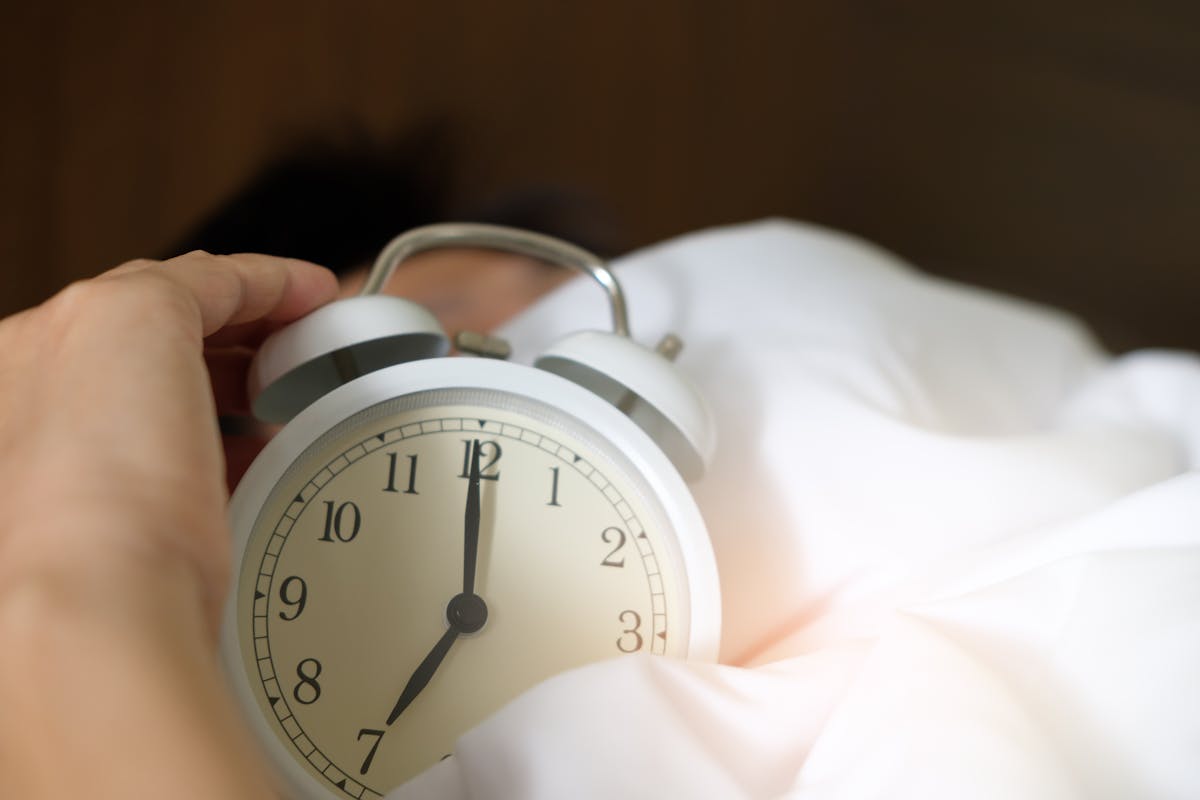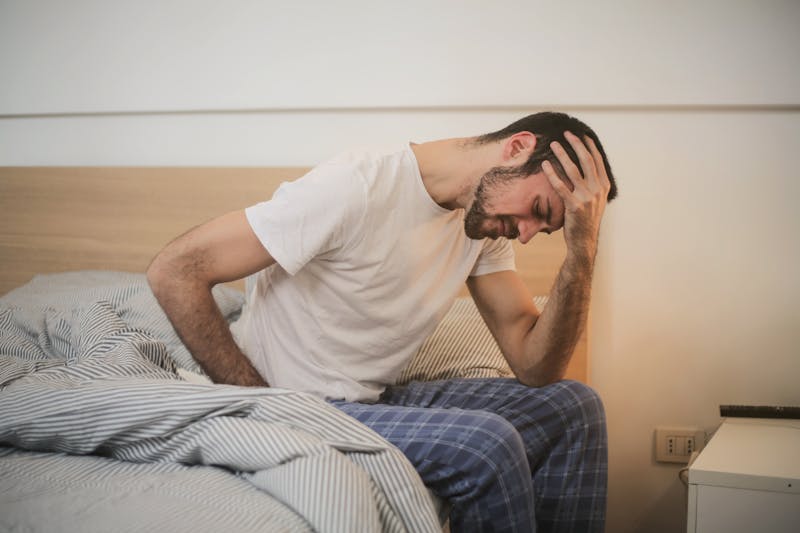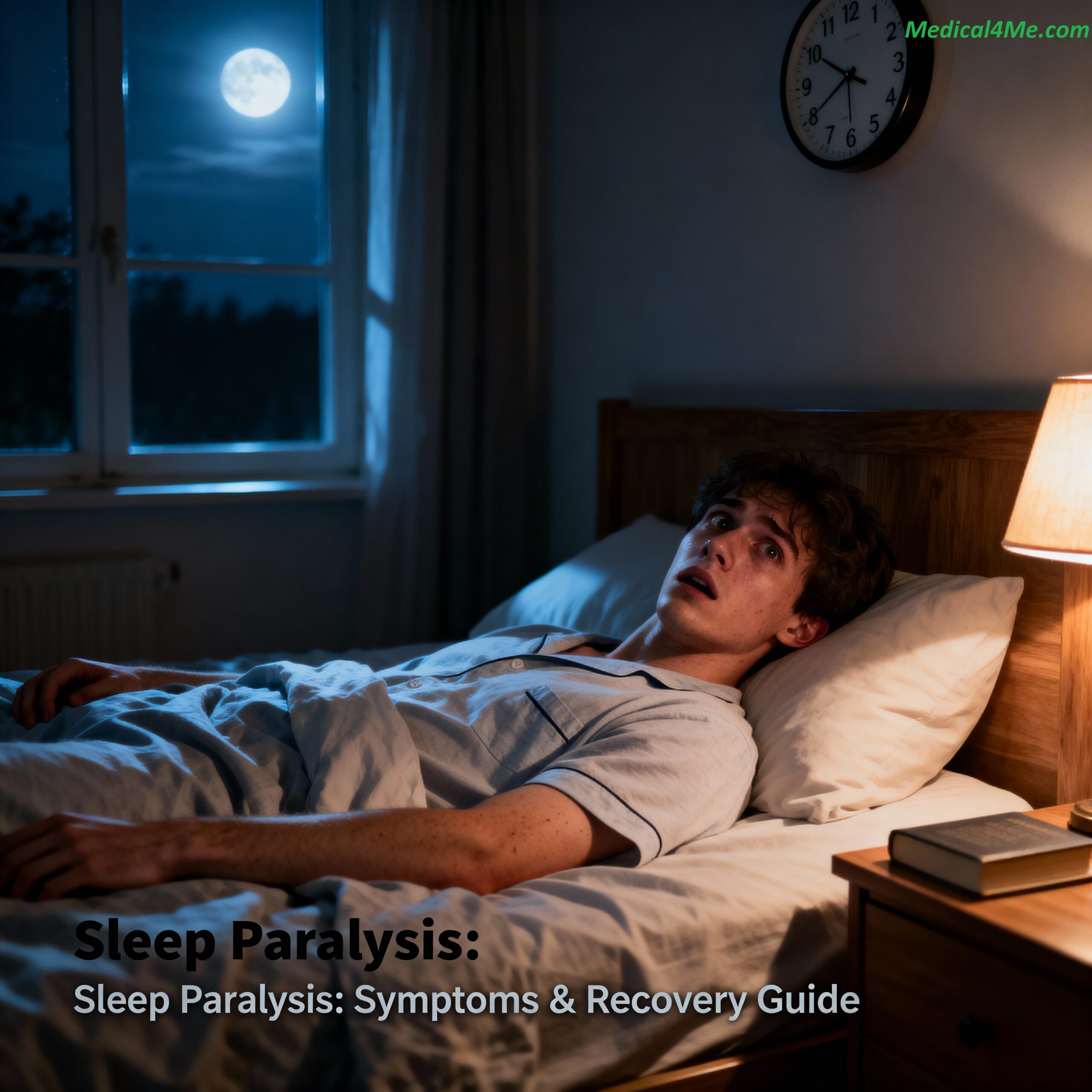Sleep Paralysis: The Terrifying Truth Behind Your Frozen Nights

Picture this: You wake up in the middle of the night, completely aware of your surroundings, but you can’t move a single muscle. Your eyes might be open, you can see your room, but your body won’t respond to your desperate commands to move. Sounds like a nightmare? For millions experiencing sleep paralysis, it’s a terrifying reality that happens while fully conscious.
Look, I get it – the first time this happens, you might think you’re having a stroke or something worse. But here’s what’s actually going on. Your brain has this clever mechanism during REM sleep that basically turns off your voluntary muscles. Usually, this switches off when you wake up. Sometimes though, there’s a glitch in the system. You become conscious while your body’s still in lockdown mode.
The numbers are pretty staggering. According to a 2023 study from the National Sleep Foundation, roughly 7.6% of the population experiences sleep paralysis at least once in their life. But for some unlucky folks, it’s a regular visitor – showing up weekly or even nightly.
What is Sleep Paralysis?
Medical Definition
Sleep paralysis is a temporary inability to move or speak that happens when you’re falling asleep or waking up. During an episode, you remain fully conscious and aware but cannot move your body, speak, or open your eyes (in some cases). This state results from a disconnect between your brain and body during transitions in and out of REM sleep, typically lasting from a few seconds to several minutes.
Now, let me break this down in simpler terms. Your brain has this amazing safety feature – during REM sleep (that’s when you dream the most), it basically puts your muscles on airplane mode. Why? Well, imagine physically acting out every dream you have. You’d be punching walls, running into furniture, maybe even jumping out windows. Not ideal, right?
Usually this system works perfectly. You fall asleep, your brain paralyzes your muscles during REM, you dream about flying or whatever, then everything switches back on when you wake. But sometimes – and here’s where sleep paralysis comes in – your conscious mind wakes up while the paralysis switch is still flipped to “on.”
What makes this experience so absolutely terrifying isn’t just the paralysis itself. It’s the whole package. People report feeling a crushing weight on their chest, sensing an evil presence in the room, or seeing shadowy figures. Some folks describe it as feeling like they’re being suffocated or dragged off the bed. These aren’t supernatural events – they’re hypnagogic hallucinations, basically waking dreams that your panicked brain creates.
In my years of treating patients with sleep disorders, I’ve heard it all. One patient described seeing an old woman sitting on her chest every single time. Another swore he could hear footsteps circling his bed. These hallucinations are so common that different cultures have created their own explanations – from the “Old Hag” in Anglo-Saxon folklore to the “Pinyin” in China.
The medical term for these episodes is actually “isolated sleep paralysis” when it happens on its own, or “recurrent isolated sleep paralysis” when it keeps coming back. When it’s linked to other conditions like narcolepsy, we call it secondary sleep paralysis.
Recognizing Symptoms and Signs
Identifying sleep paralysis isn’t always straightforward because, honestly, when you’re in the middle of an episode, rational thinking goes out the window. But knowing what to expect can make the experience less frightening.
🟢 Mild Symptoms:
- Complete inability to move your limbs, torso, or head
- Can’t speak or call for help (though you desperately want to)
- Full awareness of your environment
- Ability to breathe (though it may feel difficult)
- Episodes lasting under 60 seconds
🟡 Moderate Symptoms:
- Feeling of pressure or weight on your chest
- Sensation that someone or something is in the room
- Hearing strange sounds (footsteps, whispers, static)
- Feeling like you’re floating or having an out-of-body experience
- Episodes lasting 2-5 minutes
🔴 Severe Symptoms:
- Vivid visual hallucinations (intruders, demons, aliens)
- Feeling of being touched, grabbed, or choked
- Extreme panic and fear of dying
- Multiple episodes in one night
- Episodes lasting over 5 minutes

Here’s something interesting – the timing matters a lot. If you experience temporary sleep paralysis while falling asleep, we call that hypnagogic or predormital sleep paralysis. If it happens when you’re waking up (which is way more common), that’s hypnopompic or postdormital sleep paralysis.
The physical sensations can vary wildly. Some people feel like they’re sinking into their mattress, while others feel like they’re levitating. You might experience tingling, vibrations, or even feel like electricity is running through your body. And the auditory hallucinations? They range from simple buzzing to complex conversations.
What really messes with people is the time distortion. An episode that lasts 30 seconds can feel like 30 minutes when you’re trapped in your own body. Your heart’s racing, you’re trying to scream, and every second stretches out like taffy.
Understanding Causes and Risk Factors
So why does sleep paralysis happen to some people and not others? Well, it’s complicated. There’s no single cause, but rather a perfect storm of factors that can trigger these episodes.
Major Contributing Factors:
- Sleep Deprivation (40% of cases): This is the big one. When you’re running on fumes, your brain gets desperate for REM sleep and can jump into it at weird times, increasing your risk of REM sleep paralysis.
- Stress and Anxiety (30% of cases): High stress messes with your sleep architecture. People with anxiety disorders are significantly more likely to experience episodes.
- Sleep Schedule Disruption (25% of cases): Shift workers, new parents, jet-lagged travelers – anyone with an inconsistent sleep schedule is at higher risk.
- Sleep Position (20% of cases): Sleeping on your back (supine position) dramatically increases your chances. Nobody knows exactly why, but it might relate to breathing patterns or blood flow.
- Genetics (10-15% of cases): If your parents or siblings have experienced it, you’re more likely to as well. There seems to be a hereditary component.
Medical conditions play a huge role too. significantly increase your risk. People with panic disorder are especially vulnerable – about 35% of them experience regular sleep paralysis episodes. Other conditions linked to higher rates include depression, bipolar disorder, and PTSD.
Medications can be a trigger as well. Certain antidepressants, particularly SSRIs and SNRIs, can increase REM sleep pressure. ADHD medications, especially stimulants taken late in the day, mess with your sleep cycles. Even some blood pressure medications have been linked to increased episodes.
Here’s something that surprised me when I first learned it: substance use is a major factor. Not just illegal drugs – I’m talking about everyday stuff. Alcohol withdrawal can trigger episodes. Too much caffeine disrupts your sleep architecture. And marijuana? While some people use it for sleep, suddenly stopping after regular use can cause REM rebound, leading to intense dreams and, you guessed it, sleep paralysis.
Age-wise, teenagers and young adults get hit the hardest. Peak onset is between 14-17 years old, though it can start at any age. Interestingly, it often decreases as people get older, unless they develop other sleep disorders.
The Diagnostic Journey
Getting a proper diagnosis for sleep paralysis can be… well, frustrating. Many doctors aren’t super familiar with it, and patients often feel embarrassed describing their experiences. “Doc, I see demons when I wake up” isn’t exactly an easy conversation starter.
Step 1: Initial Consultation
Your physician will start with a detailed history. They want to know everything – when episodes occur, how often, what you experience. Don’t hold back. Even the weird stuff is medically relevant.
Step 2: Sleep Diary Documentation
You’ll keep a detailed log for 2-4 weeks. Document bedtimes, wake times, any episodes, stress levels, food, drinks, medications. This helps identify patterns. You might discover your episodes only happen after late-night Netflix binges or stressful workdays.
Step 3: Physical Examination
Your doctor will check for underlying conditions. Blood work might include thyroid function (hypothyroidism can affect sleep), vitamin D levels (deficiency is linked to sleep problems), and markers for autoimmune conditions.
Step 4: Specialized Testing (if needed)
Most people don’t need a sleep study, but if your doctor suspects narcolepsy or sleep apnea, you might spend a night at a sleep lab. The polysomnography records brain waves, oxygen levels, heart rate, and breathing patterns. Some patients also get a Multiple Sleep Latency Test (MSLT) to check how quickly they enter REM sleep.
The diagnostic process usually takes 4-8 weeks total. For most people, the diagnosis is made based on symptoms alone. But ruling out other conditions is crucial – what looks like sleep paralysis could be seizures, panic attacks, or other parasomnias.
Treatment Options Comparison
| Treatment Method | Success Rate | Time to Effect | Monthly Cost | Side Effects |
|---|---|---|---|---|
| Sleep Hygiene Changes | 60-75% | 1-3 weeks | $0-30 | None |
| Cognitive Behavioral Therapy | 70-85% | 4-8 weeks | $400-1500 | None |
| Antidepressants | 55-70% | 2-4 weeks | $15-150 | Moderate |
| Sleep Position Therapy | 35-50% | 1-2 weeks | $20-80 | None |
| Meditation/Relaxation | 50-65% | 3-6 weeks | $0-50 | None |
Treatment really depends on frequency and severity. For occasional episodes, lifestyle changes might be enough. But if you’re dealing with this weekly or nightly, you need a more aggressive approach.
Sleep hygiene is always the first line of defense. And I know, I know – everyone talks about sleep hygiene like it’s some magic cure. But seriously, maintaining a regular sleep schedule, avoiding screens before bed, keeping your room cool and dark – these basics work for a lot of people. [SOURCE: CDC] reports that proper sleep hygiene alone can reduce parasomnia episodes by up to 60%.
Cognitive Behavioral Therapy for sleep paralysis (CBT-SP) is incredibly effective. It helps you understand the condition, manage the fear, and develop coping strategies. The therapy often includes exposure exercises where you mentally rehearse episodes while calm, reducing the panic when they actually occur.
Medication is usually reserved for severe cases or when sleep paralysis is part of narcolepsy. SSRIs like fluoxetine can suppress REM sleep, reducing episodes. Some doctors prescribe tricyclic antidepressants like clomipramine, which have shown good results. But medications come with trade-offs – side effects, cost, and the fact that episodes often return when you stop taking them.
Prevention Strategies
Daily Prevention Routine
- Get 7-9 hours of sleep consistently
- Go to bed and wake up at the same time daily
- Avoid back sleeping – use pillows to stay on your side
- No caffeine after 2 PM (seriously!)
- Create a wind-down routine starting 1 hour before bed
Prevention is absolutely key with sleep paralysis disorder. Once you know your triggers, you can often avoid episodes entirely.
Weekly Prevention Activities:
- Exercise at least 3-4 times (but not within 3 hours of bedtime)
- Practice stress management techniques like yoga or meditation
- Review and adjust your sleep environment
- Limit alcohol intake, especially near bedtime
- Check in with yourself about stress levels
Monthly Prevention Assessment:
- Review your sleep diary for patterns
- Evaluate any new medications with your doctor
- Assess work/life balance and make adjustments
- Consider seasonal factors affecting your sleep
Diet matters more than you might think. Heavy meals before bed can trigger episodes. Some people find that certain foods – particularly those high in sugar or processed carbs – increase their risk. Magnesium deficiency has been linked to sleep disorders, so consider adding magnesium-rich foods or supplements (after talking to your doctor, of course).
The bedroom environment is crucial. Your room should be a sleep sanctuary – cool (around 65-68°F), dark, and quiet. Blackout curtains, white noise machines, comfortable mattress and pillows – these aren’t luxuries when you’re dealing with a sleep disorder.
When to Seek Medical Help
Seek Medical Attention When:
- Episodes occur more than once per week
- You experience sudden muscle weakness during emotions (cataplexy)
- Episodes happen during daytime naps
- You’re avoiding sleep due to fear
- Episodes last longer than 10 minutes
- You have difficulty staying awake during the day
Don’t tough it out if sleep paralysis is ruining your life. I’ve seen too many patients suffer for years before seeking help. The fear of episodes can create a vicious cycle – you’re anxious about sleeping, which increases stress, which triggers more episodes.
Red flags that need immediate evaluation include sudden onset of frequent episodes after age 40 (could indicate neurological issues), episodes accompanied by severe headaches (possible increased intracranial pressure), or any episodes with loss of bladder control (might be seizures, not sleep paralysis).
Finding the right medical professional matters. Start with your primary care doctor, but don’t be surprised if you need a referral to a sleep specialist. Sleep Disorders and other sleep conditions often coexist with sleep paralysis, so comprehensive evaluation is important.
Patient Story: Jake’s Recovery
Jake, a 32-year-old software developer, started experiencing sleep paralysis during a particularly stressful project deadline. “The first time, I literally thought I was being abducted by aliens. I could see these gray figures around my bed, couldn’t move, couldn’t scream. I was convinced I was going to die.” Episodes increased to 3-4 times per week, and Jake started dreading bedtime, often staying awake until exhaustion forced him to sleep.
After consulting a sleep specialist, Jake learned his triggers: work stress, irregular sleep schedule, and excessive caffeine. He implemented strict sleep hygiene, started CBT, and switched from back to side sleeping. Six months later, he experiences maybe one episode every couple months. “Understanding what was happening took away most of the fear. Now if it happens, I just focus on wiggling my toes and remind myself it’ll pass. The terror is gone.”

Latest Research & Developments
The field of sleep medicine is exploding with new research on sleep paralysis. A groundbreaking 2024 study from MIT found that people who experience frequent episodes have different brain connectivity patterns in regions controlling arousal and movement. This discovery could lead to targeted treatments.
Researchers at Oxford University published findings in March 2024 showing that a specific breathing technique – 4-7-8 breathing practiced during episodes – can shorten duration by up to 50%. The study involved 200 participants and used EEG monitoring to verify results. Basically, you breathe in for 4, hold for 7, exhale for 8. Simple but effective.
Virtual reality therapy is showing incredible promise. [SOURCE: NIH] is funding research into VR exposure therapy where patients can safely experience and practice managing simulated episodes. Early results show 65% reduction in episode-related anxiety after just 8 sessions.
Gene therapy might be on the horizon too. Scientists at Stanford identified specific genetic markers associated with sleep paralysis susceptibility. While we’re years away from gene therapy, this research helps identify high-risk individuals and could lead to preventive treatments. The study examined over 5,000 participants across 15 countries, making it the largest genetic study of sleep paralysis to date.

Frequently Asked Questions
Taking Control of Your Sleep Again
Living with sleep paralysis doesn’t mean accepting a lifetime of terrifying nights. Now that you understand what’s really happening – your brain’s just having a minor hiccup with its sleep-wake switch – you can approach this condition with knowledge instead of fear.
The most important things to remember? First, nocturnal paralysis episodes are temporary and harmless, no matter how scary they feel. Second, most people see dramatic improvement with simple lifestyle changes. And third, effective treatments exist for even the most stubborn cases.
Start tonight. Pick one or two prevention strategies and commit to them for a week. Maybe it’s setting a strict bedtime, or finally dealing with that stress that’s been eating at you. Small changes can lead to big improvements. Track your progress, identify your triggers, and don’t hesitate to seek professional help if you need it.
Remember, millions of people have overcome sleep paralysis. You’re not broken, you’re not haunted, and you’re definitely not alone. With the right approach and a bit of patience, peaceful nights are absolutely within reach.
This content is for informational purposes only and is not a substitute for professional medical advice, diagnosis, or treatment. Always seek the advice of your physician or other qualified health provider with any questions you may have regarding a medical condition. Never disregard professional medical advice or delay in seeking it because of something you have read on Medical4Me.com.

💬 Share Your Experience
Share your thoughts, questions, or personal tips below. Our community and editorial team value respectful and insightful discussions.